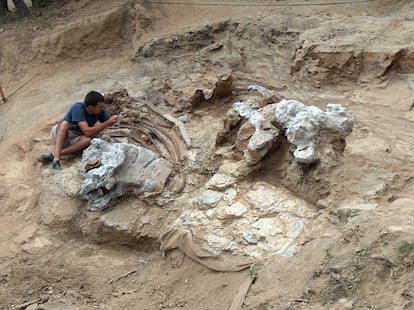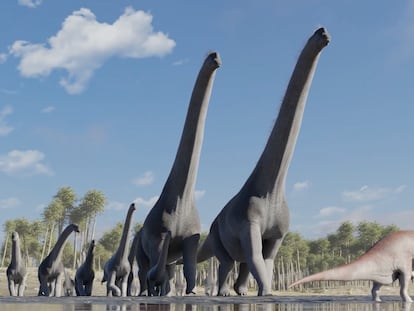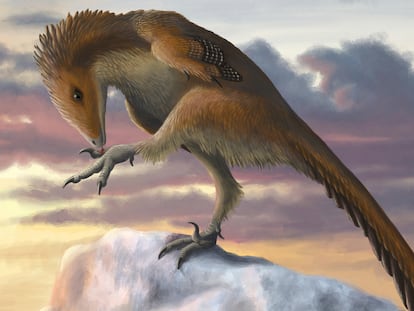‘Garumbatitan’, the new species of giant dinosaur identified in Spain
The quadruped — which walked an area of Castellón 122 million years ago — stood 10 meters tall, ate up to 40 kilos of vegetation a day and is considered one of the ‘most gigantic’ of its kind
Researchers in Spain have identified a new species of sauropod dinosaur, which lived in the Iberian Peninsula 122 million years ago. The discovery, described in the Zoological Journal of the Linnean Society, was made in Morella, a municipality in the province of Castellón, in the Valencia region. According to the research, the dinosaur from the Early Cretaceous stood 10 meters tall.
To get an idea of its gigantic size, think of the opening scene of the movie Jurassic Park (1993). In this scene, astonished doctor Alan Grant stares fixedly at a brachiosaurus walking the slopes of an island, converted into a theme park of cloned dinosaurs. “Garumbatitan morellensis could be compared to this specimen,” says paleontologist José Miguel Gasulla.
This is the sixth new dinosaur species to be discovered in Valencia, five of which were found in Morella. The discovery expands the diversity of dinosaurs known to have inhabited the mountainous Castellón region of Els Ports, which has one of the best fossil records from the Early Cretaceous in Europe.

Garumbatitan morellensis was a quadruped and herbivore, capable of ingesting up to 30 or 40 kilos of vegetation daily. With its long neck and long tail, it was one “of the most gigantic” dinosaurs on record, say paleontologists José Miguel Gasulla and Francisco Ortega, from the UNED Evolutionary Biology Group in Spain, which organizes paleontological surveys in Morella and took part in the study.
The name of the new species is in honor of its size: Garumbatitan means “the giant of the Garumba,” since the specimen was found at the base of the Muela de la Garumba, one of the peaks of Els Ports. Morellensis refers to Morella, the municipality where the site is located. The work was led by Pedro Mocho, from the University of Lisbon. Researchers from the Catalan Institute of Paleontology, Grup Guix de Vila-real geological association, the Museum of Natural Sciences of Valencia, Jaume I University and the Autonomous University of Madrid also participated in the research.
The size of the now classified fossil remains — located in different surveys carried out between 2005 and 2008 — pays testament to its massive dimensions. It had meter-long vertebrae, a two-meter tall femur and two-meter-long ribs. It also had two almost complete articulated feet, “which are particularly rare in the fossil record,” according to the researchers.
The dinosaur’s morphology was also unique compared to other sauropods. “This tendency towards gigantism is very evident here: just look at how the limbs are attached to the waist. They are wide-track animals, which open the pelvis and scapulae, so they walk very wide. The femur is inclined inward, because they open their waist a lot when they move, and that modifies the structure of the hind legs,” says Ortega. The researcher points out that their upper limbs virtually have no digits, and that they walk on top of their metacarpals, “as if walking on tiptoe.”
The study also analyzes the relationship between the Garumbatitan morellensis and the other sauropod dinosaurs from the Early Cretaceous that inhabited the Iberian Peninsula. The new species described in Morella is one of the most primitive members of a group of sauropods called Somphospondyli. This group was one of the most diverse and abundant during the Early Cretaceous, and became extinct at the end of the Mesozoic.
In the study, the researchers explore the complex evolutionary history of sauropods from the European Cretaceous, particularly from the Iberian Peninsula, with species related to lineages present in Asia and North America, as well as with some groups close to species on the African continent. “This suggests there were moments of fauna dispersion between these continents,” the researchers say.
The description of this new species also sheds light on the ecosystems of the Early Cretaceous, which was one of the goals of the research in Morella. “We are finding pieces of the puzzle that allow us to see a little better what this part of the structure of the ecosystems was like.” The area contains an estuary and is surrounded by mountains. Researchers believe that the Garumbatitan morellensis inhabited the furthest part of the estuary, moving through an extensive forested area with large trees “capable of supporting the amount of food that herds of specimens of these dimensions needed.”

Researchers hope future excavation at the site will provide “key information” to understanding the initial evolution of the sauropods. Some 60% of fossils remain buried in the region, and are still pending classification. “There is still a way to go, but we are getting there,” say Gasulla and Ortega, who are hoping to “bring to light” this heritage. “There is a lot to show,” they add.
“Here in this region we say that tota pedra fa paret — every stone makes a wall — and this stone is helping to build the paleontological wall, because it is big,” says Gasulla with a laugh. Garumbatitan morellensis provides a new piece of the puzzle, which is being solved by the researchers at Els Pont.
Sign up for our weekly newsletter to get more English-language news coverage from EL PAÍS USA Edition
Tu suscripción se está usando en otro dispositivo
¿Quieres añadir otro usuario a tu suscripción?
Si continúas leyendo en este dispositivo, no se podrá leer en el otro.
FlechaTu suscripción se está usando en otro dispositivo y solo puedes acceder a EL PAÍS desde un dispositivo a la vez.
Si quieres compartir tu cuenta, cambia tu suscripción a la modalidad Premium, así podrás añadir otro usuario. Cada uno accederá con su propia cuenta de email, lo que os permitirá personalizar vuestra experiencia en EL PAÍS.
¿Tienes una suscripción de empresa? Accede aquí para contratar más cuentas.
En el caso de no saber quién está usando tu cuenta, te recomendamos cambiar tu contraseña aquí.
Si decides continuar compartiendo tu cuenta, este mensaje se mostrará en tu dispositivo y en el de la otra persona que está usando tu cuenta de forma indefinida, afectando a tu experiencia de lectura. Puedes consultar aquí los términos y condiciones de la suscripción digital.
More information
Archived In
Últimas noticias
Most viewed
- Sinaloa Cartel war is taking its toll on Los Chapitos
- Reinhard Genzel, Nobel laureate in physics: ‘One-minute videos will never give you the truth’
- Oona Chaplin: ‘I told James Cameron that I was living in a treehouse and starting a permaculture project with a friend’
- Why the price of coffee has skyrocketed: from Brazilian plantations to specialty coffee houses
- David King, chemist: ‘There are scientists studying how to cool the planet; nobody should stop these experiments from happening’










































